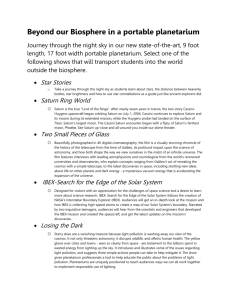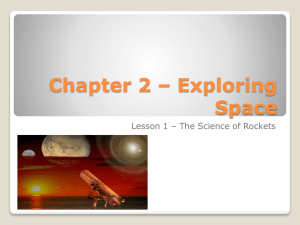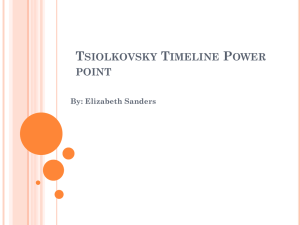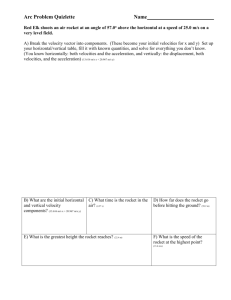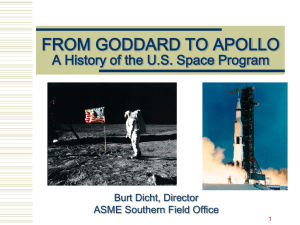Process Description – Saturn V Launch
advertisement
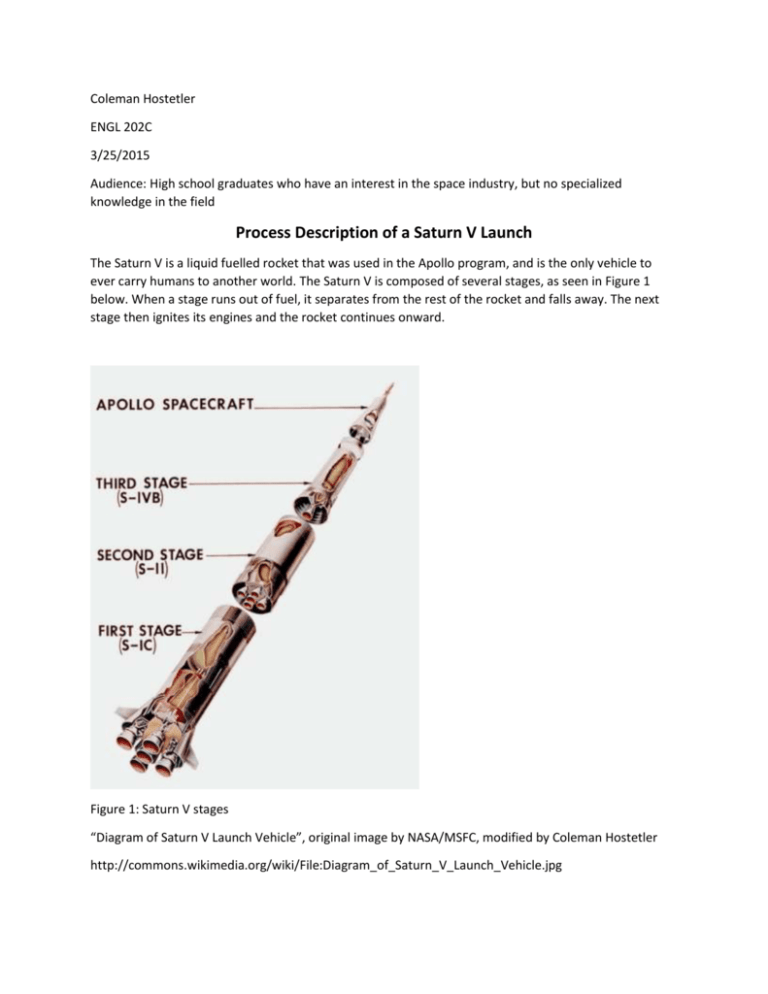
Coleman Hostetler ENGL 202C 3/25/2015 Audience: High school graduates who have an interest in the space industry, but no specialized knowledge in the field Process Description of a Saturn V Launch The Saturn V is a liquid fuelled rocket that was used in the Apollo program, and is the only vehicle to ever carry humans to another world. The Saturn V is composed of several stages, as seen in Figure 1 below. When a stage runs out of fuel, it separates from the rest of the rocket and falls away. The next stage then ignites its engines and the rocket continues onward. Figure 1: Saturn V stages “Diagram of Saturn V Launch Vehicle”, original image by NASA/MSFC, modified by Coleman Hostetler http://commons.wikimedia.org/wiki/File:Diagram_of_Saturn_V_Launch_Vehicle.jpg First Stage The first stage, powered by five of the most powerful rocket engines ever made, produces over 7.5 million pounds of thrust. This stage uses a highly refined form of kerosene and liquid oxygen as fuel. The first stage is mostly spent on lifting the Saturn V up through the dense lower atmosphere. The rocket ascends straight up at first, but gradually pitches downward. This is because getting into orbit requires horizontal velocity much more than it requires altitude. As the rocket ascends, its rate of acceleration increases, for three reasons. First, the performance of the engines improves at higher altitudes. Second, higher altitude means thinner atmosphere and less drag. Lastly, the first stage burns through 14 tons of fuel per second, making the rocket lighter and easier to accelerate. After 2 minutes and 41 seconds, the first stage has burned all 4.7 million pounds of its fuel, and the rocket is 42 miles up, travelling at over 6000 mph. The first stage then separates from the rocket and falls away. Then the second stage’s engines ignite. Second Stage The second stage has five smaller engines and is fuelled by liquid hydrogen and liquid oxygen. The fuel is different from the first stage because the heavier kerosene provides more thrust, which is very important for getting the rocket off the ground. Liquid hydrogen is much lighter, which means it provides less thrust, but also means that the first stage doesn’t have to lift as much weight, and functions as a more efficient fuel. The second stage is intended to get the rocket very close to orbit, but on a path that will still reenter the Earth’s atmosphere. This is to ensure that the stage will fall back to Earth, landing in the ocean, rather than staying in orbit and adding to the incredible amount of orbital debris already up there. The launch trajectory of the second stage, unlike the first, is not preprogrammed. Instead, the most fuel-efficient trajectory is calculated in real time by the onboard computer. The second stage burns for 6 minutes, and brings the rocket to an altitude of 109 miles and a velocity of 15,647 mph, very close to orbital velocity. Third Stage The third stage has a single rocket engine, and unlike the first two stages, it is focused more on efficiency than thrust. Like the second stage, it uses liquid hydrogen and liquid oxygen as fuel. The engine fires for 2.5 minutes before being shut off, leaving the spacecraft in a temporary parking orbit at an altitude of about 118 miles, travelling at 17,432 mph. This orbit is only temporary though, and the third stage’s engine ignites again to put the rocket on course for the moon. The amount of time spent in a parking orbit varied depending on the mission, and was around 2.5 hours for Apollo 11. The burn to transfer to the moon lasts about six minutes, and brings the spacecraft close to Earth’s escape velocity of 25,053 mph, the velocity needed to break free of Earth’s gravitational pull. Up until this point, the rocket was just getting into orbit, so all it had to do was point forward and accelerate. Things work very differently now that it is in orbit, and all maneuvers must be carefully calculated beforehand. In order to put the spacecraft on an intercept course with the moon, it isn’t enough to simply point the spacecraft at the moon and fire the engines. Instead, the spacecraft has to be put on an orbit that will cross paths with the moon’s orbit when both the moon and the spacecraft are in that location. This maneuver is known as a Trans-Lunar Injection, or TLI, and can be seen in Figure 2 below. Figure 2: Trans-Lunar Injection “Perspective View of a Lunar Transfer Trajectory” by Aresv, used under CC BY SA / new label added from original http://en.wikipedia.org/wiki/File:Tli.svg Apollo Spacecraft About 40 minutes after the burn to put the spacecraft on course for the moon, the third stage separates from the Command Service Module (CSM). The CSM then turns back towards the third stage and docks with the landing module inside the third stage. Once the spacecraft arrives at the moon, it isn’t in orbit yet. If nothing is done, it will simply fly right past the moon. To get captured into a lunar orbit, the spacecraft has to slow down by turning backwards and firing its engine, what is known as ‘burning retrograde’. Lunar Landing After orbiting the moon a few times, the landing module detaches from the CSM, then waits until it has drifted far enough away to fire its engine. Once it has reached a safe distance, the landing module decelerates, dropping from lunar orbit and putting itself on course for the surface. Lunar landings are performed on an area of the moon where it is either dusk or dawn, so that the long shadows cast by rocks on the surface can allow the astronauts in the landing module to judge how high above the surface their lander is. The initial phase of the landing was entirely computer controlled, reducing velocity relative to the lunar surface to near zero, at an altitude around 10000 ft. Control of the landing module was given back to crew for the final approach, which took them down to about 700 ft. The descent stage had enough fuel to hover above the lunar surface for about two minutes, so the crew could survey the landing site and ensure that it was safe to land. The pilot of the lander then had to touch down safely, ensuring that the craft’s horizontal and vertical velocity were minimized so it didn’t get damaged or tip over upon landing. Getting to the moon is a lengthy process, spanning several days and consisting of atmospheric ascent, entry into Earth orbit, Trans-Lunar injection, entry into lunar orbit, and finally descent and landing. All of NASA’s moon landings were launched with a Saturn V, and went through these steps as well as several more to return the astronauts on board the rocket safely back to Earth.




